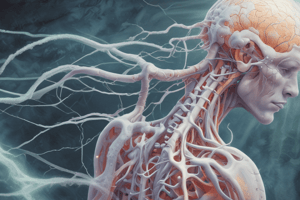Podcast
Questions and Answers
Which part of the skull surrounds and protects the brain?
Which part of the skull surrounds and protects the brain?
- Occipital bone
- Viscerocranium
- Frontal bone
- Neurocranium (correct)
How many parietal bones are present in the skull?
How many parietal bones are present in the skull?
- 2 (correct)
- 1
- 3
- 4
Which bone articulates with the vertebral column?
Which bone articulates with the vertebral column?
- Temporal bone
- Occipital bone (correct)
- Ethmoid bone
- Frontal bone
What is the functional significance of accessory bones in the skull?
What is the functional significance of accessory bones in the skull?
Which of the following is not a part of the neurocranium?
Which of the following is not a part of the neurocranium?
What is the total number of bones present in the skull, including both the viscerocranium and neurocranium components?
What is the total number of bones present in the skull, including both the viscerocranium and neurocranium components?
What type of joints are found between the skull sagittal bones?
What type of joints are found between the skull sagittal bones?
Which bones form the floor of the cranial cavity's posterior cranial fossa?
Which bones form the floor of the cranial cavity's posterior cranial fossa?
How many nasal bones are present in the facial skeleton?
How many nasal bones are present in the facial skeleton?
What part of the brain is housed in the middle cranial fossa?
What part of the brain is housed in the middle cranial fossa?
Which bone is responsible for forming the lateral view of the facial skeleton?
Which bone is responsible for forming the lateral view of the facial skeleton?
What is the name of the bone that forms the condylar process in the features of the mandible?
What is the name of the bone that forms the condylar process in the features of the mandible?
Which bone is NOT part of the neurocranium?
Which bone is NOT part of the neurocranium?
Which bone contributes to the formation of the optic canal?
Which bone contributes to the formation of the optic canal?
Which bone forms part of the viscerocranium?
Which bone forms part of the viscerocranium?
Which foramen is not correctly paired with its location?
Which foramen is not correctly paired with its location?
Which bone is not visible in the superior view of the skull?
Which bone is not visible in the superior view of the skull?
What is the main focus of ANAT 316 course?
What is the main focus of ANAT 316 course?
Where should students go for their labs in ANAT 316?
Where should students go for their labs in ANAT 316?
What is NOT a part of the learning outcomes for 'The Skull' lecture in ANAT 316?
What is NOT a part of the learning outcomes for 'The Skull' lecture in ANAT 316?
How should students behave during lectures in ANAT 316 according to the provided information?
How should students behave during lectures in ANAT 316 according to the provided information?
What is a fundamental competency that everyone should strive towards during ANAT 316 lectures?
What is a fundamental competency that everyone should strive towards during ANAT 316 lectures?
What is provided to students for self-directed learning in ANAT 316 labs?
What is provided to students for self-directed learning in ANAT 316 labs?
Which bone forms part of the orbital wall and nasal cavity/septum in the skull?
Which bone forms part of the orbital wall and nasal cavity/septum in the skull?
What is the function of the crista galli in the ethmoid bone?
What is the function of the crista galli in the ethmoid bone?
Which structure in the ethmoid bone allows branches of CN I (olfactory nerve) to pass through?
Which structure in the ethmoid bone allows branches of CN I (olfactory nerve) to pass through?
What is another name for the cribriform plate of the ethmoid bone?
What is another name for the cribriform plate of the ethmoid bone?
Which part of the sphenoid bone forms part of the eye orbit and the base of the skull?
Which part of the sphenoid bone forms part of the eye orbit and the base of the skull?
What is the structure in the sphenoid bone that resembles a 'Turkish Saddle'?
What is the structure in the sphenoid bone that resembles a 'Turkish Saddle'?
Flashcards are hidden until you start studying




